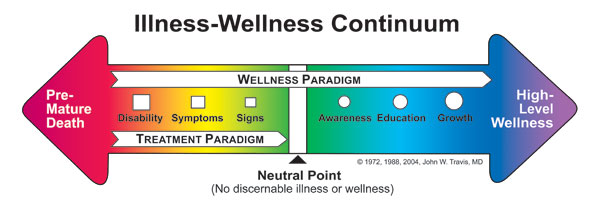Key Concept #1: The Illness-Wellness Continuum
Wellness is a process, never a static state.
Most of us think of wellness in terms of illness; we assume that the absence of illness indicates wellness. There are actually many degrees of wellness, just as there are many degrees of illness. The Illness-Wellness Continuum illustrates the relationship of the treatment paradigm to the wellness paradigm.

Moving from the center to the left shows a progressively worsening state of health. Moving to the right of center indicates increasing levels of health and wellbeing. The treatment paradigm (drugs, herbs, surgery, psychotherapy, acupuncture, and so on) can bring you up to the neutral point, where the symptoms of disease have been alleviated. The wellness paradigm, which can be utilized at any point on the continuum, helps you move toward higher levels of wellness. The wellness paradigm directs you beyond neutral and encourages you to move as far to the right as possible. It is not meant to replace the treatment paradigm on the left side of the continuum, but to work in harmony with it. If you are ill, then treatment is important, but don't stop at the neutral point. Use the wellness paradigm to move toward high-level wellness.
Even though people often lack physical symptoms, they may still be bored, depressed, tense, anxious, or simply unhappy with their lives. Such emotional states often set the stage for physical and mental disease. Even cancer can be brought on by excessive stress that weakens the immune system. Negative emotional states can also lead to abuse of the body through smoking, overdrinking alcohol, and overeating - attempts to substitute for other more basic human needs such as acknowledgment and respect, a stimulating and supportive environment, and a sense of purpose and meaning.
Wellness is not a static state. High-level wellness involves giving good care to your physical self, using your mind constructively, expressing your emotions effectively, being creatively involved with those around you, and being concerned about your physical, psychological, and spiritual environments. In fact, it's not so much where you are on the continuum, but which direction you're facing. High-level wellness does not preclude periods of illness and weakness, nor does it attempt to deny that death is a natural part of life. (As you'll find in the section Wellness and Finding Meaning, dying can be done from a place of wellness). Awareness of this paradox eventually led us to expand the model, but first a little background.
The Illness-Wellness Continuum was first envisioned by John in 1972, late one evening after everyone else at his office in the U.S. Public Health Service Hospital in Baltimore, Maryland, had gone home. It was a melding of the health risk continuum created by Lewis Robbins (creator of the Health Risk Appraisal) and Abraham Maslow's concept of self-actualization.
Once it was published in 1975, the continuum became an immediate success, an easy way to illustrate what this newly emerging wellness concept was all about. Health practitioners and educators began using it; soon it was appearing in books, journals, and slide presentations everywhere around the world. We naturally included it in the first edition of this book, and we continue to do so because of its visual impact. To this day it is reprinted in health and medical textbooks worldwide.
However, a simple model cannot always convey a complex concept. For a number of years we had recognized that the continuum could be misleading in one very significant area. We knew it is possible to be physically ill yet oriented toward wellness, or to be physically healthy yet functioning from an illness mentality. Our one-dimensional model simply couldn't show this distinction. For example, imagine disabled, sick, or dying people who are taking responsibility for their lives and are consciously engaged in the experience. If only the physical dimension were considered, they would fall on the left side of the continuum, but if emotional, intellectual, and spiritual dimensions are taken into account they would definitely be on the right side of the continuum.


